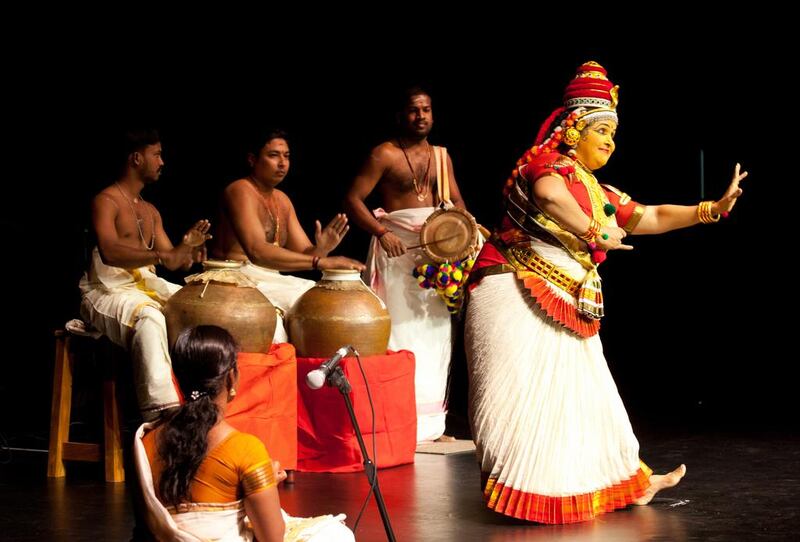Not many women in India choose a Sanskrit theatre that’s more than 2,000 years old as their profession. But Margi Sathi not only picked koodiyattam, she also contributed immensely to the evolution of a strong feminine narrative of the ancient art form, while resuscitating nangiarkoothu, a women-only offshoot that dates back to the 10th century.
An early start
Now the leading female face of koodiyattam, Sathi enrolled as a student in Kalamandalam, Kerala’s premier performing arts institute.
“Kalamandalam was near our home and, as a child, I used to go with my grandmother for kathakali performances. Since I showed a keen interest at an early age, my father enrolled me there for koodiyattam. Painkulam Rama Chakyar, the guru who set up the department of koodiyattam, was the first to take students from other castes,” says Sathi, who performed in Dubai for the International Koodiyattam and Kathakali Festival during the National Day weekend.
Sathi was 11 when she joined the hostel in Kalamandalam, where koodiyattam was taught in the old gurukula tradition, with students living in the arts centre so they could focus their life on the art.
Rigorous training
Mastering koodiyattam, which Unesco recognises as part of the Intangible Cultural Heritage of Humanity, was no easy feat. Sathi spent eight years at Kalamandalam, receiving rigorous instruction in physical training, discipline and lessons in the ancient language of Sanskrit.
“We had to reach class by 7am and until 8.30am we had to practise kannasadhakam [eye exercises], navrasa [facial expressions] and mudra [hand gestures]. Once the teacher came, we performed sadhakam – ‘firming’ the body by standing on bent feet with a straight back while memorising Sanskrit verses, sometimes for as long as two hours,” says Sathi, who performed at the Unesco headquarters in Paris in 2001.
“After that, we had Sanskrit class followed by cholliyattam [practising choreographed sections of plays], till 12.30. After lunch, we had Sanskrit literature class from 3 to 5pm ... and more eye exercises from 7 to 8pm.”
The feminine narrative
So how did she become a torchbearer of nangiarkoothu, the feminine narrative, and what sets it apart from koodiyattam?
“After I got married, I moved to Thiruvananthapuram and joined the Margi dance institute. Its founder, D Appukuttan Nair, asked if I had learnt nangiarkoothu. And, surprisingly, I had no idea even though I had learnt the basics of it through my koodiyattam lessons,” recalls Sathi.
In koodiyattam, several characters perform on stage but nangiarkoothu is a solo act, where an actress takes on multiple roles while narrating the story through stylised dance movements, expressions and hand gestures.
Sathi began her research, referring to books and ancient texts and then wrote the attaprakarams, or choreographies, and staged the entire Shri Krishnavatharam (Life of Lord Krishna) in nangiarkoothu in a bid to revive it.
“Then I wanted to do something new, but I was also worried about unwittingly altering the structural form of an art dating back 1,500 to 2,000 years,” she admits.
Starting new projects
She tackled that in her enactment of Sreeramacharitham (the story of Rama from the Ramayana) – from Rama’s wife Sita’s point of view – a project that led to her first book in 1999.
“That itself was a big change, as it was an attaprakaram of nangiarkoothu after a gap of maybe 800 years,” she explains.
The other plays she conceptualised with female protagonists include Sitayanam, a three-part choreography describing Sita’s emotions at significant junctures of the Ramayana, and Kannagicharitham based on the Tamil epic Silapathikaram.
But Sathi is quick to talk about the contributions of others. “Similarly, my senior Usha Nangiar, Kalamandalam Girija and Kalamandalam Shailaja have also broken barriers and brought new experiments in the art form on stage.”
And this evolution helped get more girls interested in koodiyattam. “While I was learning in Kalamandalam, there were only one or two girls ... now there are around 30,” she says.
Asked about her appearance in critically acclaimed films, she says: “Oh. I did those only to popularise koodiyattam ... I’ll always prefer to be known as a nangiarkoothu artist than a film actress.”
artslife@thenational.ae
Follow us @LifeNationalUAE
Follow us on Facebook for discussions, entertainment, reviews, wellness and news.





